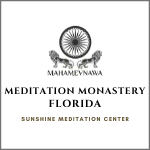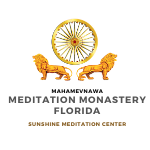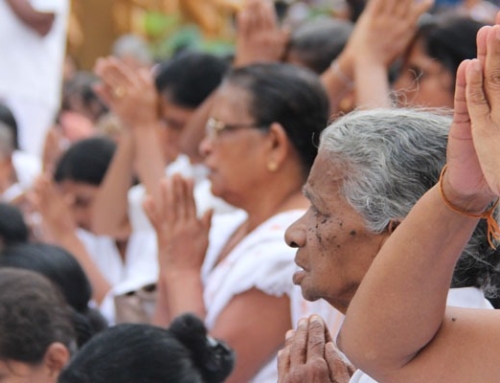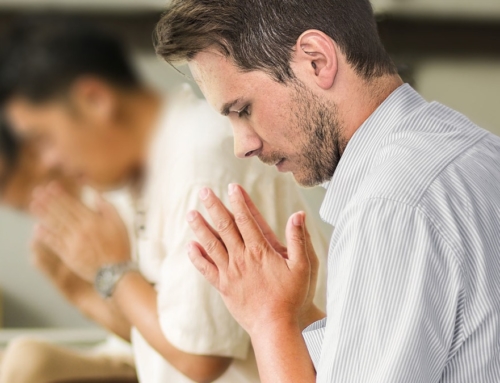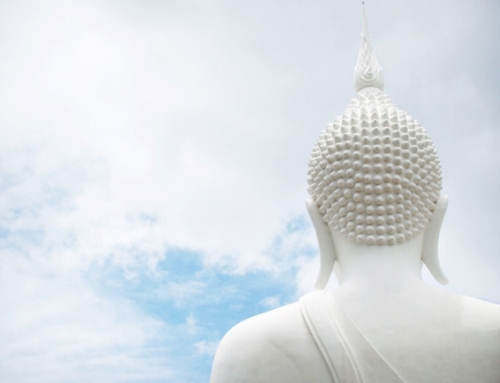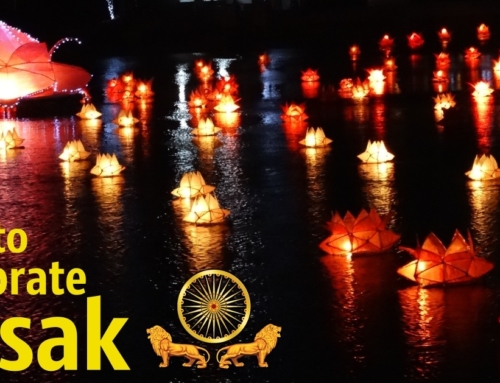Excerpt from www.mahamevnawabm.org
The month in which Arahants were first born in Sri Lanka
The true and utmost day of dignified freedom for Sri Lankans is the Poson Poya day. On this day, Sri Lankans received the Buddha's Dhamma, which is the most valued possession of the country, even at present. People in this country used to go hunting and worshiping various supernatural things like trees and stones. On a day like this, that life pattern of the Sri Lankans was changed forever when they received the gift of the Dhamma. They were fortunate enough to become a generation full of great sages who achieved the fruits of the Dhamma by following the middle path. We received that great gift of Dhamma from Arahant Mihindhu Thero.
Just within the first month of Arahant Mihindhu Thero's arrival, the Sri Lankan people were fortunate enough to listen to many Dhamma discourses. But, the Buddhists at present would not be able to listen to those great discourses of the Buddha even if they listen to Dhamma sermons for several years at this present time. The Mahavansha mentions about the Dhamma discourses preached by the Arahant Mihindu Thero in His first period of time in Sri Lanka. It is our intention to explore and discuss about those discourses in this article.
Arahant Mihindu Thero's first sermon was the 'Chūlahatthipadōpama Sutta', which was included in the Majjhima Nikāya. This discourse explains how a disciple recognizes the Samma Sambuddhahood of the Buddha by attaining the path-and-fruition of the path that the Buddha disclosed to them, in a similar way that a person who knows well about elephants would differentiate a (male) elephant from female elephants. Arahant Mihindu Thero preached that Sutta in a fruitful way, so that the King Devana Patis and the royal crowd were well established in the refuge of the Triple Gem.
Thereafter, all deities were invited by the novice monk Sumana to listen to Arahant Mihindu Thero's preaching of the Samachitta Pariyāya Sutta (from the Anguttara Nikāya) to them. In this Sutta, it is explained how deities who share similar wise minds, will realize the Dhamma.
Queen Anula and her group got the chance to listen to the Dhamma the following day. They were able to listen to good descriptions about Karma and Karmaphala (results of Karma) from Mihindu Thero. It was done by delivering the Prēta Vatthu and Vimāna Vatthu from the Khuddakha Nikāya. Prēta Vatthu includes stories about people who are born in ghost world by performing sinful acts in their lives. Vimāna Vatthu includes stories about people who are born in divine worlds by performing meritorious deeds in their lives. Using stories in these discourses, Mihindu Thero explained how beings will get these births as long as they still lack the wisdom and knowledge to realize the Four Noble Truths. Mihindu Thero then preached them the Sachcha Samyutta (the Samyutta Nikāya) that includes a detailed description of the Four Noble Truths. There are 135 discourses of the Buddha in Sachcha Samyutta of the Samyutta Nikāya. The benefit of realizing the Four Noble Truths and its rareness are well described in Sachcha Samyutta.
Arahant Mihindu Thero next got the chance to preach the Dhamma to the rest of the inhabitants of Sri Lanka. Arahant Thero preached them suttas such as the Dēvadūta Sutta, which well describes how a normal human being who doesn't realize life would be born in Niraya (a dangerous hell) after performing sinful deeds from the present life. Next, the Thero preached Bālapandita Sutta (from the Majjhima Nikaya), which comprised of detailed information about how a person of sinful acts fall into birth in hell while the one who cultivates merits receive a birth in one of the divine worlds.
Arahant Mihindu Thero next preached the Aggikkhandhōpama Sutta from Anguttara Nikāya. This Sutta explains the dangerous fate that comes to corrupted Buddhist monks who would use prerequisites donated by devotees. That discourse also reveals the virtuous nature of the Bhikkhu Sanghas.
The Aasivisōpama Sutta of the Samyutta Nikāya is the next discourse that Mihindu Thero preached. This Sutta compared life comprised of four elements (Dhātu) to four venomous snakes and explains the true nature of life beautifully. How fortunate would those Sri Lankans at that time be to listen to this beautiful discourse from an Arahant?
There are twenty discourses in the Anamatagga Samyutta of the Samyutta Nikāya that describe how beings are suffering inSamsara because they could not realize the Four Noble Truths. Arahant Mihindu Thero preached those twenty discourses next.
Khajjaniiya Sutta explains the Dukkha Aariya Sachcha (truth of suffering) in a detailed manner. It is also found in the Samyutta Nikāya. It expounds how Pancha Upādānakkandha is formed again and again because it is liked by beings and how the beings who like it get victimized by it. It is indeed not a surprise to see that many people who listened to thisDhamma discourse, realized the Dhamma.
Our Teacher's first sermon, the Dhammachakka Pavattana Sutta, also belongs to Samyutta Nikāya. Sri Lankans had the fortune to listen to that Dhamma discourse as well.
They were also fortunate to listen to the Appamāda Sutta, which explains the value of being vigilant (not being late). This discourse can be found in the Majjhima Nikāya.
Arahant Mihindu Thero preached all these discourses within one month. Rainy Season started afterwards. Mihindu Thero was compassionate enough to preach Vassūpanāikakkhandhaka from Mahāvagga Pālhi of Vinaya Pitaka before starting to reside in one place in the Rainy Season. This discourse contains everything about Rainy Season. Before that Rainy Season, sixty Arahants were born in this island. There were sixty eight Arahants, including Mihindu Thero and the rest of the group who came to Sri Lanka for spreading the Dhamma, by that time. Sri Lankans made 68 rooms in Mihintala Caves for the Arahants to reside and received the true gift of the Order of the Gautama Buddha.
Most of the traditions such as offering hundred thousands of flowers, performing grand processions, making Wesak lanterns and Thoran we see today in the name of Buddhism actually belong to Buddhist culture and not to the true Buddhism. If our country's Theros start to preach the Buddha's discourses like the Arahant Mihindu Thero did, this island will truly become the Dhamma Land again.
– Ven. Kiribathgoda Gnanananda Thero

